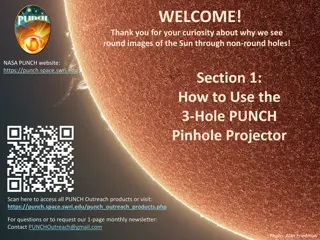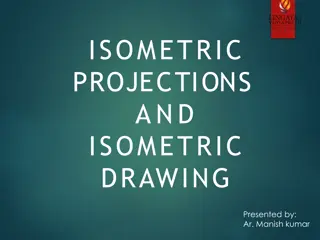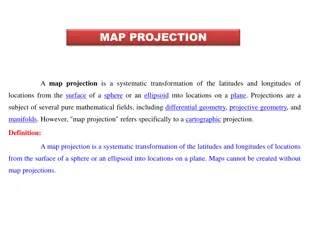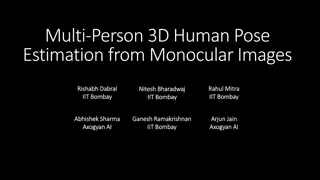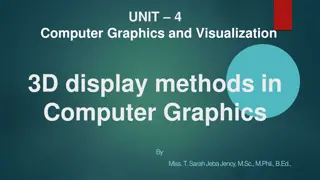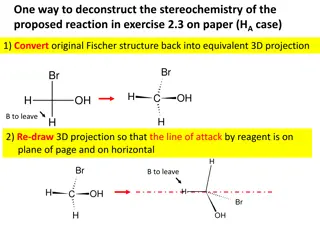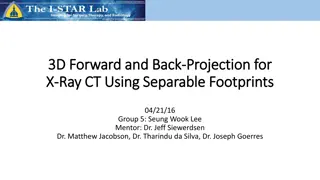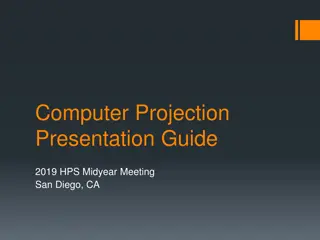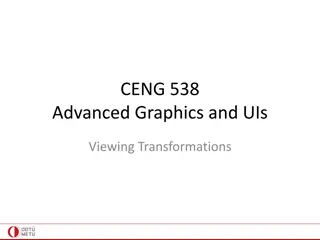Projection Theory and Methods
"Projection theory is a method to represent 3D objects in 2D planes using specific parameters and lines of sight. The theory involves different views, such as parallel and convergent projections, with varying orientations and classifications. Utilizing techniques like multiview drawing and orthographic projection, it allows for the visualization and depiction of objects in a clear and concise manner."
Download Presentation

Please find below an Image/Link to download the presentation.
The content on the website is provided AS IS for your information and personal use only. It may not be sold, licensed, or shared on other websites without obtaining consent from the author.If you encounter any issues during the download, it is possible that the publisher has removed the file from their server.
You are allowed to download the files provided on this website for personal or commercial use, subject to the condition that they are used lawfully. All files are the property of their respective owners.
The content on the website is provided AS IS for your information and personal use only. It may not be sold, licensed, or shared on other websites without obtaining consent from the author.
E N D
Presentation Transcript
Projection Theory Projection is a method to represent 3D object into 2D plane(paper etc.) Object View Therefore we need at least tow or three views (except for especial cases)
Projection Parameters The projection theory is based on 3 variables: 1- center sight point(station point) 2- Line of sight 3- Plane of projection Therefore View is the image on a projection plane
Lines of sight Lines of Parallel Projection Convergent Projection Play Play
Lines of sight The parallel projection lines can be normal (orthogonal) or oblique to the plane of projection. We consider only a parallel and orthogonal projection, i.e. orthographic projection. Orthogonal Oblique Play Play
Views View depends on a relative orientation between an object and a plane. Normal Rotation Tilting Multiview Drawing Axonometric Drawing
PROJECTION CLASSIFICATION Projections Convergent Parallel Orthogonal Oblique Multiview Axonometric Perspective Drawing Pictorial drawing Multiview drawing
PROJECTION METHOD Perspective Parallel Oblique Orthographic Axonometric Multiview
First angle method First -European countries - ISO standard quadrant Third angle method Opaque Planes - Canada, USA - Japan, Thailand Transparent Planes Third quadrant
First angle system (Opaque planes) Third angle system (transparent planes/glass box)
TOP VIEW First angle method FRONT VIEW LEFT SIDE VIEW FRONT VIEW LEFT SIDE VIEW Third angle method TOP VIEW
Third angle system First angle system 1.7d d 2.2d
Views Dimensions Width Height Height Height Depth Depth Width Depth Width
Projections of points, lines and planes
NOTATIONS FOLLOWING NOTATIONS SHOULD BE FOLLOWED WHILE NAMEING DIFFERENT VIEWS IN ORTHOGRAPHIC PROJECTIONS. OBJECT POINT A LINE AB IT S TOP VIEW a a b IT S FRONT VIEW a a b IT S SIDE VIEW a a b SAME SYSTEM OF NOTATIONS SHOULD BE FOLLOWED INCASE NUMBERS, LIKE 1, 2, 3 ARE USED.
PROJECTIONS OF A POINT IN FIRST QUADRANT POINT A IN HP & INFRONT OF VP POINT A ABOVE HP & IN VP POINT A ABOVE HP & INFRONT OF VP For Tv For Tv For Tv PICTORIAL PRESENTATION PICTORIAL PRESENTATION A a a A Y Y Y a a a X X X A a ORTHOGRAPHIC PRESENTATIONS OF ALL ABOVE CASES. Fv above xy, Tv below xy. Fv above xy, Tv on xy. Fv on xy, Tv below xy. VP VP VP a a a X Y X Y X Y a a a HP HP HP
PROJECTIONS OF STRAIGHT LINES INFORMATION REGARDING A LINE means IT S LENGTH, POSITION OF IT S ENDS WITH HP & VP IT S INCLINATIONS WITH HP & VP WILL BE GIVEN. AIM:- TO DRAW IT S PROJECTIONS - MEANS FV & TV. SIMPLE CASES OF THE LINE 1. A VERTICAL LINE ( LINE PERPENDICULAR TO HP & // TO VP) 2. LINE PARALLEL TO BOTH HP & VP. 3. LINE INCLINED TO HP & PARALLEL TO VP. 4. LINE INCLINED TO VP & PARALLEL TO HP. LINE INCLINED TO BOTH HP & VP. STUDY ILLUSTRATIONS GIVEN ON NEXT PAGE SHOWING CLEARLY THE NATURE OF FV & TV OF LINES LISTED ABOVE AND NOTE RESULTS. 5.
Orthographic Pattern For Tv (Pictorial Presentation) V.P. a Note: a Fv is a vertical line Showing True Length & Tv is a point. A Fv 1. FV b A Line b Y perpendicular to Hp & // to Vp X Y B a b TV Tv a b X H.P. Orthographic Pattern V.P. (Pictorial Presentation) Note: For Tv Fv & Tv both are // to xy & both show T. L. 2. Fv a b b A Line // to Hp & // to Vp B a X Y Y A b a b Tv X a H.P.
V.P. Fv inclined to xy Tv parallel to xy. b 3. b B A Line inclined to Hp and parallel to Vp a Y X Y a a (Pictorial presentation) b A T.V. b X a H.P. Orthographic Projections V.P. Tv inclined to xy Fv parallel to xy. 4. Fv a b b A Line inclined to Vp and parallel to Hp a B A X Y a (Pictorial presentation) Tv b a b H.P.
For Tv For Tv A Line inclined to both Hp and Vp 5. b b (Pictorial presentation) B B Y Y a On removal of object i.e. Line AB Fv as a image on Vp. Tv as a image on Hp, a A A X a b X T.V. a b T.V. V.P. b FV a X Y Orthographic Projections Fv is seen on Vp clearly. To see Tv clearly, HP is rotated 900downwards, Hence it comes below xy. Note These Facts:- Both Fv & Tv are inclined to xy. (No view is parallel to xy) Both Fv & Tv are reduced lengths. (No view shows True Length) a TV H.P. b
FRONT VIEW SIDE VIEW TOP VIEW
FRONT VIEW SIDE VIEW TOP VIEW
SIDE VIEW FRONT VIEW TOP VIEW
FRONT VIEW SIDE VIEW TOP VIEW
FRONT VIEW SIDE VIEW TOP VIEW
FRONT VIEW SIDE VIEW TOP VIEW
FRONT VIEW SIDE VIEW TOP VIEW
FRONT VIEW SIDE VIEW TOP VIEW
SIDE VIEW FRONT VIEW TOP VIEW
FRONT VIEW SIDE VIEW TOP VIEW
Orthographic writing Procedure 152 Front 45 1. Decide the suitable number of views 20 Top 2. Layout the decided views on a drawing sheet. 64 152 Choose a drawing scale (say 1:1) 3. Draw details of each selected views. y Front y 4. Write dimensions and , if any, notes. x x z y Top y x x
Front view selection The longest dimension of an object should be presented as a width (in an front view). First choice Second choice appropriate It requires less space Inappropriate It requires More space
Front view selection 2. The adjacent views projected from the selection elevation view should be appeared in a natural position. Inappropriate
Front view selection 3. It has the fewest number of hidden lines. Good Inappropriate
Selection of other views with the front view 1. Choose the adjacent view that has the fewest number of hidden lines. Inappropriate Inappropriate
Selection of other views with the front view 2. Choose the minimum number of views that can represent the major features of the object. NOT GOOD - Hole s information is placed on a separated view. FRONT VIEW RIGHT SIDE VIEW Necessary Necessary GOOD -All hole s information is placed on a single view. TOP VIEW
Selection of other views with the front 3. Choose the views that are suitable to a drawing sheet. Poor Not enough space for dimensioning. Good Change orientation of the selected views. Choose another adjacent view. Good
Examples on view selection
Important Notes Generally, three views of orthographic drawing are enough to describes an object s information. .1 2. In some specific cases, a necessary view may be less or more than three views.
Objects require only one view 1. Flat (thin) part having a uniform thickness such as a gasket, sheet metal etc. Example 1 Thick Adjacent views provide only a part s thickness !
Objects require only one view Cylindrical-shaped part. Example 2 Example 1 Deduce from center line Repeat !
Objects require two views 1. Identical adjacent view exists. 2. The 3rdview provides no additional information Example 1 Repeat !
Objects require two views 1. Identical view exists. Example 1
Objects require two views 2. The 3rdview provides no additional information Example 2
EXAMPLES FOR ORTHOGRAPHIC PROJECTIONS



